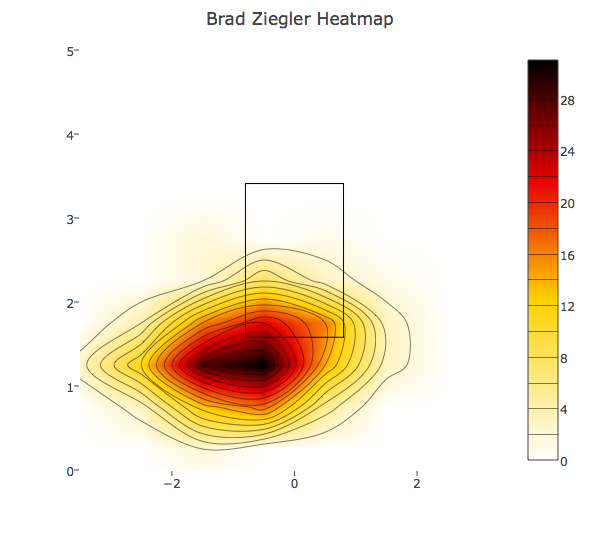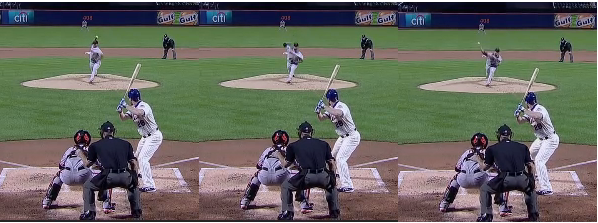The Hardest Pitches in Baseball to Lay Off
One of the great virtues of baseball is its abundance of individual, miniature virtues, which are appreciated to varying extents by some, and perhaps go unnoticed by others. Maybe one of the small things you enjoy looking for is what a player does with his batting gloves upon reaching first base. Is he a back-pocket kinda guy? Give them to the first base coach? Hold ’em in one hand while he runs the bases? Keep them on the entire time? Or how about a pitcher’s tendencies between pitches? When does he go to the rosin bag, and how often? Does he walk around the mound, or kick dirt? Take off the hat, run the fingers through the hair? Lick the hand? You could just be enthralled by a very particular type of pitch — say, a backdoor two-seam fastball, or a splitter in the dirt. Maybe you’re captivated by the different ways in which players react when they feel slighted by questionable calls.
We enjoy baseball, in a larger sense, because of the competition, and the displays of human achievement. The storylines, and the lessons to be learned. Our childhood, and a sense of both geographical and familial pride. On a more primitive level, we probably just find pleasure in watching dingers and heaters. But it’s the little intricacies that we only notice after countless hours playing and watching the sport that we adopt as our own and grow attached to that give us a deeper appreciation for the game that we love.
One of my favorite small pleasures in baseball is a well-executed check swing. Baseball is such a reactionary game, where the margins are in the milliseconds, and the check swing is a beautiful tug of war between a human’s physical reactionary ability and cognitive reactionary ability. The moment a pitcher releases that breaking ball destined for the dirt, the hitter’s first reaction is to hunt, and his limbs are set in motion. Yet, instantaneously, like an evolving caveman playing with fire, the brain kicks in and says “Nuh uh uh, remember what happened last time?” and sends that signal to the limbs to stop what they’re doing just in time to lay off the pitch that would’ve been strike three, had the brain waited a split-second longer to intervene.
But the brain doesn’t always get that signal out in time. Whether by fault of the batter or by virtue of the pitcher, you as a batter are sometimes halfway through your swing when you have the dreadful realization that, “Crap, I shouldn’t be swinging right now.” Some batters have a greater ability to halt their ill-advised swings than others, and on the other hand, some pitchers have a greater ability to prevent check swings. Some pitchers can throw junk ball after junk ball that hitters just can’t lay off. Using BaseballSavant’s PITCHf/x search, I was able to identify these pitches, those which batters had the hardest time laying off last year. Let’s dive in.
Changeup – Brad Ziegler
- Thrown out of the zone: 85% of the time
- Swung at, when out of the zone: 54% of the time
- Meaning: 46% of the time this pitch is thrown, it’s both a) out of the zone and b) swung at
This was the hardest pitch in all of baseball to lay off last year, by my methodology. Which makes sense, given it could just be the rarest pitch in baseball. Yes, that’s right. Eno Sarris wrote about this very pitch at length for FOXSports last year, noting the oddity of a submarine pitcher throwing a changeup.
Sarris explains:
“You pronate (‘pull down’ on the inside the ball for a righty) with the changeup and supinate (pull down on the outside of the ball) with breaking pitches, generally.
…
There are only three true submariners pitching right now. But it also seems like the physics of throwing a changeup from down under make things difficult. Try to mimic pulling down on the inside of the ball from that angle, and you’ll see that it is difficult to pull off.”
The way a changeup’s spin is achieved and the way a submariner’s mechanics work are like oil and water, yet Ziegler has found a way to blend the two. Few batters have ever seen a pitch that moves like Ziegler’s from Ziegler’s arm slot, and so it makes sense that they have a hard time laying off.
When I first watched the video, the pitch didn’t actually look that low, but it was actually the lowest changeup Ziegler threw that got a swing all year. Must be the deception. And the fact that he puts it right about there every time:

It’s almost never a strike, yet batters keep swinging, and Ziegler is able to pound that one corner of the plate, low-and-outside to lefties, low-and-inside to righties. Of the 118 pitchers who threw at least 200 changeups last year, Ziegler’s had the sixth-highest swing rate, and the third-highest ground ball rate.
Curveball – Yusmeiro Petit
- Thrown out of the zone: 68% of the time
- Swung at, when out of the zone: 61% of the time
- Meaning: 42% of the time this pitch is thrown, it’s both a) out of the zone and b) swung at
Petit has, by far, the most extreme chase rate numbers for any curveball in the game. And, surprise, it’s another pitch about which Eno has written! Eno is pretty good at this stuff. In what is one of my favorite pieces in recent memory, Eno wrote about Petit’s “invisiball” — the ability he has to momentarily hide the ball with his mechanics, which can be seen in this illuminating series of screencaps:

Just like Ziegler, there’s the deception, and then there’s the location:

Petit is able to expand that outside edge of the plate to right-handed batters, as seen in the .gif above to Yadier Molina. Of the 121 pitchers who threw at least 200 curveballs last year, Petit’s has the very highest swing rate, by 11 percentage points (!!!), a whiff rate in the upper 25%, and the very highest pop-up rate.
Slider – Will Smith
- Thrown out of the zone: 72% of the time
- Swung at, when out of the zone: 51% of the time
- Meaning: 37% of the time this pitch is thrown, it’s both a) out of the zone and b) swung at
Eno, unfortunately, has not yet written about this pitch, which not only means he has an assignment for the upcoming season, but that this section of the post may not be quite as interesting as the previous two. What I can tell you is this, though: every year Smith’s been in the league, his thrown this slider more and more, and every year Smith’s been in the league, his FIP has dropped. Something tells me those two things are probably related. Last year, Smith upped the slider usage to 43%, nearly overtaking the fastball as his primary pitch, and last year, he solved his issues against right-handed batters, transforming him from a LOOGY to a true relief weapon.
Could be, because, when you locate a pitch like this, it doesn’t matter on which side of the plate the hitter is standing:

Of the 166 pitchers who threw at least 200 sliders last year, Smith’s had the very highest whiff rate in all of baseball, coupled with a swing rate and a ground ball rate each in the upper 25%.
August used to cover the Indians for MLB and ohio.com, but now he's here and thinks writing these in the third person is weird. So you can reach me on Twitter @AugustFG_ or e-mail at august.fagerstrom@fangraphs.com.
That Will Smith slider heatmap is a thing of beauty.